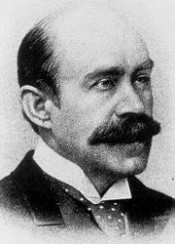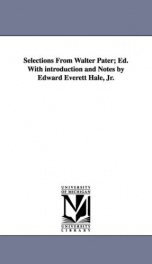Pater Walter

Walter Horatio Pater (4 August 1839 - 30 July 1894) was an English essayist, critic of art and literature, and writer of fiction. Born in Stepney in London's East End, Walter Pater was the second son of Richard Glode Pater, a doctor who had moved to London in the early 19th century and practised medicine among the poor. Dr Pater died while Walter was an infant and the family moved to Enfield, Middlesex, where Walter attended Enfield Grammar School. In 1853 Pater was sent to The King's School, Canterbury, where the beauty of the cathedral made an impression that would remain with him all his life. As a schoolboy he read John Ruskin's Modern Painters, which helped inspire his lifelong attraction to the study of art and gave him a taste for well-crafted prose. He gained a school exhibition, with which he proceeded in 1858 to Queen’s College, Oxford. As an undergraduate Pater was a shy "reading man", making few friends. The scholar Benjamin Jowett was struck by his potential and offered to give him private lessons. In Jowett's classes, however, Pater was a disappointment; he took a Second in literae humaniores in 1862. As a boy he had cherished the idea of entering the Anglican Church, but at Oxford his faith in Christianity had been shaken. He now thought of becoming a Unitarian minister, but in spite of his inclination towards the ritual and aesthetic elements of the church, he had little interest in Christian doctrine and did not pursue ordination. After graduating, Pater remained in Oxford and taught Classics and Philosophy to private students. But his years of study and reading now paid dividends: he was offered a fellowship in 1864 at Brasenose on the strength of his ability to teach modern German philosophy, and he settled down to a university career. Formative visits to the continent, combined with opportunities for wider study and teaching at Oxford, meant that Pater's preoccupations now multiplied. He became acutely interested in art and literature, and started to write articles and criticism. The first piece to be printed was an essay on Coleridge, contributed in 1866 to the Westminster Review. A few months later his essay on Winckelmann, the first expression of his idealism, appeared in the same review (1867). In the following year his sensitive study of "Aesthetic Poetry", on William Morris and the literary Pre-Raphaelites, appeared in the Fortnightly Review, to be succeeded by essays on Leonardo da Vinci, Sandro Botticelli, Pico della Mirandola and Michelangelo. The last four, with other similar pieces, were collected in his Studies in the History of the Renaissance (1873), renamed The Renaissance: Studies in Art and Poetry in the second and subsequent editions. The Leonardo essay contains his celebrated reverie on the Mona Lisa; the Botticelli essay helped revive interest in this great painter. The brief “Conclusion” to The Renaissance was to be Pater's most influential publication. It contains the core of his aesthetic philosophy, advocating a cultivation of intense receptivity to beauty and to moments of sensation, in life, art, music and literature, but saying nothing in support of the Ruskinian emphasis on art as a source of moral or social edification. Now at the centre of a small but gifted circle in Oxford (he tutored Gerard Manley Hopkins and Oscar Wilde), Pater was gaining respect in the London literary world and beyond, numbering some of the Pre-Raphaelites among his friends. In 1874 he was turned down at the last moment by his erstwhile mentor Benjamin Jowett, Master of Balliol, for a previously-promised proctorship. The reason remained a mystery until recently, when records emerged documenting an affair with a nineteen-year-old undergraduate, William Money Hardinge. Hardinge had attracted unfavorable attention as a result of his outspoken homosexuality and blasphemous verse.[1] Many of Pater's works focus on male beauty, friendship and love, either in a Platonic way or, obliquely, in a more physical way.[2] Pater next became a candidate for the Slade Professorship of Poetry at Oxford University, but withdrew from the competition in the wake of personal criticism, part of it spawned by W. H. Mallock in a satirical novel entitled The New Republic, in which Pater is depicted as a stereotypically effeminate English aesthete. Conscious of his growing influence and aware that the "Conclusion" to his Renaissance could be misconstrued as amoral, Pater now set about clarifying and exemplifying his ideas through fiction. In his philosophical novel Marius the Epicurean (1885), set in the Rome of the Antonines, he displays, with much intellectual elaboration and poetic feeling but with little narrative interest, his ideal of the aesthetic life, his philosophy of beauty tempered by aestheticism, and his theory of the stimulating effect of the pursuit of beauty as an ideal in itself. The novel's opening and closing episodes betray Pater's continuing nostalgia for the atmosphere, ritual and community of the religious faith he had lost. In 1887 Pater published Imaginary Portraits, four psychological studies of fictional characters in historical settings, each of them in part a disguised self-portrait. The "Imaginary Portrait" was a genre in which he came to specialise. Here his examination of the tensions between intellect and sensation, asceticism and aestheticism, social mores and amorality, becomes increasingly complex. Implied warnings against the pursuit of extremes in matters intellectual, aesthetic or sensual are unmistakable. The third portrait, "Sebastian van Storck", a powerful critique of philosophical solipsism, is perhaps Pater's most striking work of fiction. Appreciations, with an Essay on Style was published in 1889, with a revised second edition in 1890. Its "Preface" argues for a subjective, impressionistic response to art and literature, as opposed to the drier, more objective and somewhat moralistic criticism practised by Matthew Arnold and others. Pater's suppression in the revised edition of his fine essay on "Aesthetic Poetry", however, suggests either an increasing conservatism on his part, or (more probably) a growing cautiousness in face of hostile criticism by an establishment unnerved by his reputation for "hedonism". In 1893 appeared his scholarly Plato and Platonism, which includes a sympathetic study of ancient Sparta, and in 1894 the evocative semi-autobiographical Imaginary Portrait, The Child in the House. His mind, however, was returning to the religious interests of his youth. Those who believed they knew him best believed that, had he lived longer, he would have resumed his youthful intention of taking holy orders. This was probably wishful thinking. The evidence of his later writings points rather to no more than a revival of his earlier interest in Gothic cathedrals, sparked by regular visits to northern Europe with his sisters, with whom he now lived in north Oxford. Pater died on a college staircase, of heart failure brought on by rheumatic fever, at the age of 55. He was buried at Holywell Cemetery, Oxford. Pater's Greek Studies, with its poetic reverie on Hippolytus, and his Miscellaneous Studies, were collected posthumously in 1895. The latter contains another two obliquely self-revelatory Imaginary Portraits. His unfinished novel, Gaston de Latour appeared posthumously in 1896, the product of a growing interest in his later years in French philosophy, history, literature, and architecture; and his Essays from The Guardian were privately printed in 1897. A Collected Edition of Pater's works was issued in 1901, and was reprinted frequently until the late 1920s. Toward the end of his life Pater's writings were exercising a considerable influence. The principles of what would be known as the Aesthetic Movement were partly traceable to him, and his effect was particularly felt on one of the movement's leading proponents, Oscar Wilde. Some of the early Modernists such as Marcel Proust, Andre Gide, and W. B. Yeats admired his writing, and his influence can be traced in the subjective, stream-of-consciousness novels of the early 20th century. Idealists have found, and always will find inspiration in his desire to "burn always with this hard, gemlike flame", and in his pursuit of the "highest quality" in "moments as they pass". Pater was much admired for his prose style, which he strove to make worthy of his own aesthetic ideals, taking great pains and fastidiously correcting his work. "I have known writers of every degree, but never one to whom the act of composition was such a travail and an agony as it was to Pater," wrote Edmund Gosse, who also described Pater's method of composition: "So conscious was he of the modifications and additions which would supervene that he always wrote on ruled paper, leaving each alternate line blank."[3] As a result, Pater's style, serene and contemplative in tone, suggests, in the words of G. K. Chesterton, a "vast attempt at impartiality"[4]. Indeed in its richness, depth, and acuity, in its sensuous rhythms, his style was perfectly attuned to his philosophy of life. [1] Pater's Grave at Holywell Cemetery
do you like this author?
What readers are saying
What do you think? Write your own comment on this book!
write a commentWhat readers are saying
What do you think? Write your own comment on this author!
write a commentBook list

marius the epicurean his sensations and ideas volume 2
Series:
Unknown
Year:
Unknown
Raiting:
4/5
Show more
add to favoritesadd In favorites
Book list

marius the epicurean his sensations and ideas volume 2
Series:
Unknown
Year:
Unknown
Raiting:
4/5
Show more
add to favoritesadd In favorites

marius the epicurean his sensations and ideas volume 1
Series:
Unknown
Year:
Unknown
Raiting:
4/5
Show more
add to favoritesadd In favorites

Giordano Bruno
Series:
Unknown
Year:
Unknown
Raiting:
2.5/5
This book was converted from its physical edition to the digital format by a community of volunteers. You may find it for free on the web. Purchase of the Kindle edition includes wireless delivery.
Show more
add to favoritesadd In favorites

Aesthetic Poetry
Series:
Unknown
Year:
Unknown
Raiting:
5/5
This book was converted from its physical edition to the digital format by a community of volunteers. You may find it for free on the web. Purchase of the Kindle edition includes wireless delivery.
Show more
add to favoritesadd In favorites
What readers are saying
What do you think? Write your own comment on this author!
write a commentif you like Pater Walter try:
readers also enjoyed
What readers are saying
What do you think? Write your own comment on this author!
write a commentGenre
if you like Pater Walter try:
readers also enjoyed
Do you want to exchange books? It’s EASY!
Get registered and find other users who want to give their favourite books to good hands!


